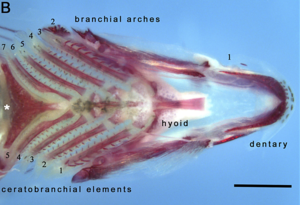Most bony fishes have two sets of jaws made mainly of bone. The primary oral jaws open and close the mouth, and a second set of pharyngeal jaws are positioned at the back of the throat. The oral jaws are used to capture and manipulate prey by biting and crushing. The pharyngeal jaws, so-called because they are positioned within the pharynx, are used to further process the food and move it from the mouth to the stomach.[2][3]
Cartilaginous fishes, such as sharks and rays, have one set of oral jaws made mainly of cartilage. They do not have pharyngeal jaws. Generally jaws are articulated and oppose vertically, comprising an upper jaw and a lower jaw and can bear numerous ordered teeth. Cartilaginous fishes grow multiple sets (polyphyodont) and replace teeth as they wear by moving new teeth laterally from the medial jaw surface in a conveyor-belt fashion. Teeth are replaced multiple times also in most bony fishes, but unlike cartilaginous fishes, the new tooth erupts only after the old one has fallen out.
Jaws probably originated in the pharyngeal arches supporting the gills of jawless fish. The earliest jaws appeared in now extinct placoderms and spiny sharks during the Silurian, about 430 million years ago. The original selective advantage offered by the jaw was probably not related to feeding, but to increased respiration efficiency—the jaws were used in the buccal pump to pump water across the gills. The familiar use of jaws for feeding would then have developed as a secondary function before becoming the primary function in many vertebrates. All vertebrate jaws, including the human jaw, evolved from early fish jaws. The appearance of the early vertebrate jaw has been described as "perhaps the most profound and radical evolutionary step in the vertebrate history".[4][5] Fish without jaws had more difficulty surviving than fish with jaws, and most jawless fish became extinct.
Jaws use linkage mechanisms. These linkages can be especially common and complex in the head of bony fishes, such as wrasses, which have evolved many specialized feeding mechanisms. Especially advanced are the linkage mechanisms of jaw protrusion. For suction feeding a system of linked four-bar linkages is responsible for the coordinated opening of the mouth and the three-dimensional expansion of the buccal cavity. The four-bar linkage is also responsible for protrusion of the premaxilla,[6] leading to three main four-bar linkage systems to generally describe the lateral and anterior expansion of the buccal cavity in fishes.[6][7] The most thorough overview of the different types of linkages in animals has been provided by M. Muller,[8] who also designed a new classification system, which is especially well suited for biological systems.
- ^ a b Fraser, G. J.; Hulsey, C. D.; Bloomquist, R. F.; Uyesugi, K.; Manley, N. R.; Streelman, J. T. (2009). "An ancient gene network is co-opted for teeth on old and new jaws". PLOS Biology. 7 (2): e1000031. doi:10.1371/journal.pbio.1000031. PMC 2637924. PMID 19215146.
- ^ Mabuchi, K.; Miya, M.; Azuma, Y.; Nishida, M. (2007). "Independent evolution of the specialized pharyngeal jaw apparatus in cichlid and labrid fishes". BMC Evolutionary Biology. 7 (1): 10. doi:10.1186/1471-2148-7-10. PMC 1797158. PMID 17263894.
- ^ Alfaro, M. E.; Brock, C. D.; Banbury, B. L.; Wainwright, P. C. (2009). "Does evolutionary innovation in pharyngeal jaws lead to rapid lineage diversification in labrid fishes?". BMC Evolutionary Biology. 9 (1): 255. doi:10.1186/1471-2148-9-255. PMC 2779191. PMID 19849854.
- ^ Cite error: The named reference
Gai2012was invoked but never defined (see the help page). - ^ Cite error: The named reference
Maisey2000was invoked but never defined (see the help page). - ^ a b Westneat, Mark W. (September 1990). "Feeding mechanics of teleost fishes (Labridae; Perciformes): A test of four-bar linkage models". Journal of Morphology. 205 (3): 269–295. doi:10.1002/jmor.1052050304. PMID 29865760. S2CID 46933606.
- ^ Olsen, Aaron M.; Camp, Ariel L.; Brainerd, Elizabeth L. (15 December 2017). "The opercular mouth-opening mechanism of largemouth bass functions as a 3D four-bar linkage with three degrees of freedom". Journal of Experimental Biology. 220 (24): 4612–4623. doi:10.1242/jeb.159079. PMID 29237766.
- ^ Muller, M (29 May 1996). "A novel classification of planar four-bar linkages and its application to the mechanical analysis of animal systems". Philosophical Transactions of the Royal Society of London. Series B: Biological Sciences. 351 (1340): 689–720. Bibcode:1996RSPTB.351..689M. doi:10.1098/rstb.1996.0065. PMID 8927640.
© MMXXIII Rich X Search. We shall prevail. All rights reserved. Rich X Search


